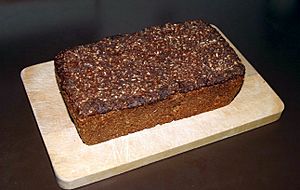Rugbrød facts for kids

A full-size loaf of rugbrød
|
|
| Type | Rye bread |
|---|---|
| Place of origin | Denmark |
| Main ingredients | Sourdough |
Rugbrød (say "roo-brood") is a very common type of rye bread from Denmark. It's a dark, dense bread that's a big part of Danish meals.
Contents
What is Rugbrød?
Rugbrød usually looks like a long, dark brown loaf. It's often around 12 centimeters (about 5 inches) tall and 30-35 centimeters (about 12-14 inches) wide. The main ingredient is rye flour. This makes a simple, heavy bread. Many popular versions today also have whole grains, like cracked rye kernels. You might also find other seeds in it, such as sunflower, flax, or pumpkin seeds.
Ingredients and Taste
The dough for rugbrød is mostly made with rye flour. Sometimes, a little bit of wheat flour, sugar, or molasses is added. This can change the taste or make the bread a bit cheaper to make. Unlike some other rye breads, rugbrød is not very sweet. It's known for its rich, slightly sour taste.
A Bit of History
For a long time, rugbrød was the most important food for many people in Denmark. It was a main part of their diet until potatoes became popular in the late 1800s. Even up to the 1950s, Danes ate much more rugbrød than they do today.
There's a Danish saying, på vand og brød, which means "on water and bread." This phrase refers to a type of punishment. In the past, people who were punished might only be given water, a set amount of rugbrød, salt, and sometimes lard. This shows how basic and essential rugbrød was considered.
How Rugbrød is Made
Making rugbrød at home can be a bit tricky. The dough almost always uses sourdough as its base. Regular commercial yeasts don't work as well for this type of bread.
The Magic of Sourdough
Sourdough is a special mix of flour and water that has natural lactic acid bacteria and yeasts living in it. These tiny living things work together:
- The yeast makes carbon dioxide gas, which helps the bread rise.
- The bacteria make lactic acid, which gives the bread its unique sour flavor.
This team effort is very important for rye bread. Rye flour creates an environment that is quite acidic. The special yeasts and bacteria in sourdough can handle this acidic environment much better than regular baking yeast. They also help break down sugars in the flour that regular yeast can't. This process makes the rugbrød taste great and rise properly.
If the dough rises for too long, the taste can become too sour. This is because certain acids can become too strong. Also, if the dough isn't handled right, the bread might not bake well. It could end up with holes or dense spots inside.
Healthy and Delicious
Rugbrød is a very healthy bread. It has little or no added oils, so it's low in fat. It's also packed with protein and dietary fiber. This makes it a great choice for a balanced diet.
Rugbrød in Danish Meals
Rugbrød is the main base for Danish open sandwiches, called smørrebrød. People spread butter on a slice of rugbrød and then pile on all sorts of toppings. These can include cold cuts, cheese, fish, or vegetables. It's a very popular and tasty way to enjoy rugbrød!
Images for kids
See also
 In Spanish: Rugbrød para niños
In Spanish: Rugbrød para niños


